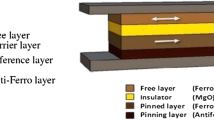Abstract
High performance low power memory is a topmost requirement in advanced computing systems. Magnetic memory has been considered as a promising solution because of its performance and non-volatility. However, it has various design challenges such as small tunneling magnetoresistance (TMR) ratios and large variability that need to be tackled for reliable operation. This chapter will discuss those challenges and introduce state-of-the-art write and read techniques.
Access this chapter
Tax calculation will be finalised at checkout
Purchases are for personal use only
Similar content being viewed by others
References
S. Yu, P.-Y. Chen, Emerging memory technologies. IEEE Solid-State Circuits Mag. 8(2), 43–56 (2016)
X. Fong, Y. Kim, S.H. Choday, K. Roy, Failure mitigation techniques for 1T-1MTJ spin-transfer torque MRAM Bit-cells. IEEE Trans. VLSI Syst. 22(2), 384–395 (2012) (Write techs. study)
T.W. Andre, J.J. Nahas, C.K. Subramanian, B.J. Garni, H.S. Lin, A. Omair, W.L. Martino, A 4-Mb 0.18-µm 1T1MTJ Toggle MRAM with balanced three input sensing scheme and locally mirrored unidirectional write drivers. IEEE J. Solid-State Circuits 40(1), 301–309, (2005) (3-input sensing and unidirectional write drivers)
D. Gogl, C. Arndt, J.C. Barwin, A. Bette, J. DeBrosse, E. Gow, H. Hoenigschmid, S. Lammers, M. Lamorey, Y. Lu, T. Maffitt, K. Maloney, W. Obermaier, A. Sturm, H. Viehmann, D. Willmott, M. Wood, W.J. Gallagher, G. Mueller, A.R. Sitaram, A 16-Mb MRAM featuring bootstrapped. IEEE J. Solid-State Circuits 40(4), 902–908 (2005) (Boostrapped write driver)
X. Bi, Z. Sun, H. Li, W. Wu, Probabilistic design methodology to improve run-time stability and performance of STT-RAM caches, in Proceedings of IEEE/ACM ICCAD, pp. 88–94 (2012) (VOW)
J. Park, T. Zheng, M. Erez, M. Orshansky, Variation-tolerant write completion circuit for variable-energy write STT-RAM architecture. IEEE Trans. VLSI Syst. 24(4), 1351–1360 (2016) (write completion, VEW)
R. Bishnoi, F. Oboril, M. Ebrahimi, M.B. Tahoori, Self-timed read and write operations in STT-MRAM. IEEE Trans. VLSI Syst. 24(5), 1783–1793 (2016) (Self-timed write)
R. Patel, X. Guo, Q. Guo, E. Ipek, E.G. Friedman, Reducing switching latency and energy in STT-MRAM caches with field-assisted writing. IEEE Trans. VLSI Syst. 24(1), 129–138 (2016) (Field-assisted writing)
T. Andre, S. Tehrani, J. Slaughter, N. Rizzo, Structures and methods for a field-reset spin-torque MRAM, U.S. Patent 8 228 715, Jul. 24, 2012
Y. Ding, Method and system for using a pulsed field to assist spin transfer induced switching of magnetic memory elements, U.S. Patent 7 502 249, Mar. 10, 2009
X. Wang et al., Magnetic field assisted STRAM cells, U.S. Patent 8 400 825, Mar. 19, 2013
J.J. Nahas, T.W. Andre, B. Garni, C. Subramanian, H. Lin, S.M. Alam, K. Papworth, W.L. Martino, A 180 Kbit Embeddable MRAM Memory Module. IEEE J. Solid-State Circuits 43(8), 1826–1834 (2007) (selective write)
C.-Y. Chen, S.-H. Wang, C.-W. Wu, Write current self-configuration scheme for MRAM yield improvement. IEEE Trans. VLSI Syst. 21(1), 1260–1270 (2012) (Write current self-config.)
M. Durlam, P.J. Naji, A. Omair, M. De Herrera, J. Calder, J.M. Slaughter, B.N. Engel, N.D. Rizzo, G. Grynkewich, B. Butcher, C. Tracy, K. Smith, K.W. Kyler, J. Jack Ren, J.A. Molla, W.A. Feil, R.G. Williams, S. Tehrani, A 1-Mbit MRAM based on 1T1MTJ Bit cell integrated with copper interconnects. IEEE J. Solid-State Circuits 38(5), 769–773 (2003) (Midpoint ref gen)
G. Jeong, W. Cho, S. Ahn, H. Jeong, G. Koh, Y. Hwang, K. Kim, A 0.24-µm 2.0-V 1T1MTJ 16-kb nonvolatile magnetoresistance RAM with self-reference sensing scheme. IEEE J. Solid-State Circuits 38(11), 1906–1910 (2003) (Self-reference)
M.B. Leslie, R.J. Baker, Noise-shaping sense amplifier for MRAM cross-point arrays. IEEE J. Solid-State Circuits 41(3), 699–704 (2006) (noise shaping and self-referencing)
Y. Chen, H. Li, X. Wang, W. Zhu, W. Xu, T. Zhang, A 130 nm 1.2 V/3.3 V 16 Kb spin-transfer torque random access memory with nondestructive self-reference sensing scheme. IEEE J. Solid-State Circuits 47(2), 560–573 (2012) (Self-reference)
J. De Brosse, D. Gogl, A. Bette, H. Hoenigschmid, R. Robertazzi, C. Arndt, D. Braun, D. Casarotto, R. Havreluk, S. Lammers, W. Obermaier, W.R. Reohr, H. Viehmann, W.J. Gallagher, G. Müller, A high-speed 128-kb MRAM core for future universal memory applications. IEEE J. Solid-State Circuits 39(4), 678–683 (2004) (Symmetrical archi)
J. Kim, K. Ryu, S.H. Kang, S.-O. Jung, A novel sensing circuit for deep submicron spin transfer torque MRAM (STT-MRAM). IEEE Trans. VLSI Syst. 20(1), 181–186 (2012) (Iref-sensing)
J. Kim, K. Ryu, J.P. Kim, S.H. Kang, S.-O. Jung, STT-MRAM sensing circuit with self-body biasing in deep submicron technologies. IEEE Trans. VLSI Syst. 22(7), 1630–1634 (2014). (sensing with body bias)
T. Sugibayashi, N. Sakimura, T. Honda, K. Nagahara, K. Tsuji, H. Numata, S. Miura, K. Shimura, Y. Kato, S. Saito, Y. Fukumoto, H. Honjo, T. Suzuki, K. Suemitsu, T. Mukai, K. Mori, R. Nebashi, S. Fukami, N. Ohshima, H. Hada, N. Ishiwata, N. Kasai, S. Tahara, A 16-Mb Toggle MRAM with burst modes. IEEE J. Solid-State Circuits 42(11), 2378–2385 (2007) (preamp)
T. Na, J. Kim, B. Song, J.P. Kim, S.H. Kang, S.-O. Jung, An offset-tolerant dual-reference-voltage sensing scheme for deep submicrometer STT-RAM. IEEE Trans. VLSI Syst. 24(4), 1361–1370 (2016) (Dual ref volt sensing)
Author information
Authors and Affiliations
Corresponding author
Editor information
Editors and Affiliations
Rights and permissions
Copyright information
© 2021 The Author(s), under exclusive license to Springer Nature Singapore Pte Ltd.
About this chapter
Cite this chapter
Kim, T.TH. (2021). Circuit Design for Non-volatile Magnetic Memory. In: Lew, W.S., Lim, G.J., Dananjaya, P.A. (eds) Emerging Non-volatile Memory Technologies. Springer, Singapore. https://doi.org/10.1007/978-981-15-6912-8_6
Download citation
DOI: https://doi.org/10.1007/978-981-15-6912-8_6
Published:
Publisher Name: Springer, Singapore
Print ISBN: 978-981-15-6910-4
Online ISBN: 978-981-15-6912-8
eBook Packages: Physics and AstronomyPhysics and Astronomy (R0)




